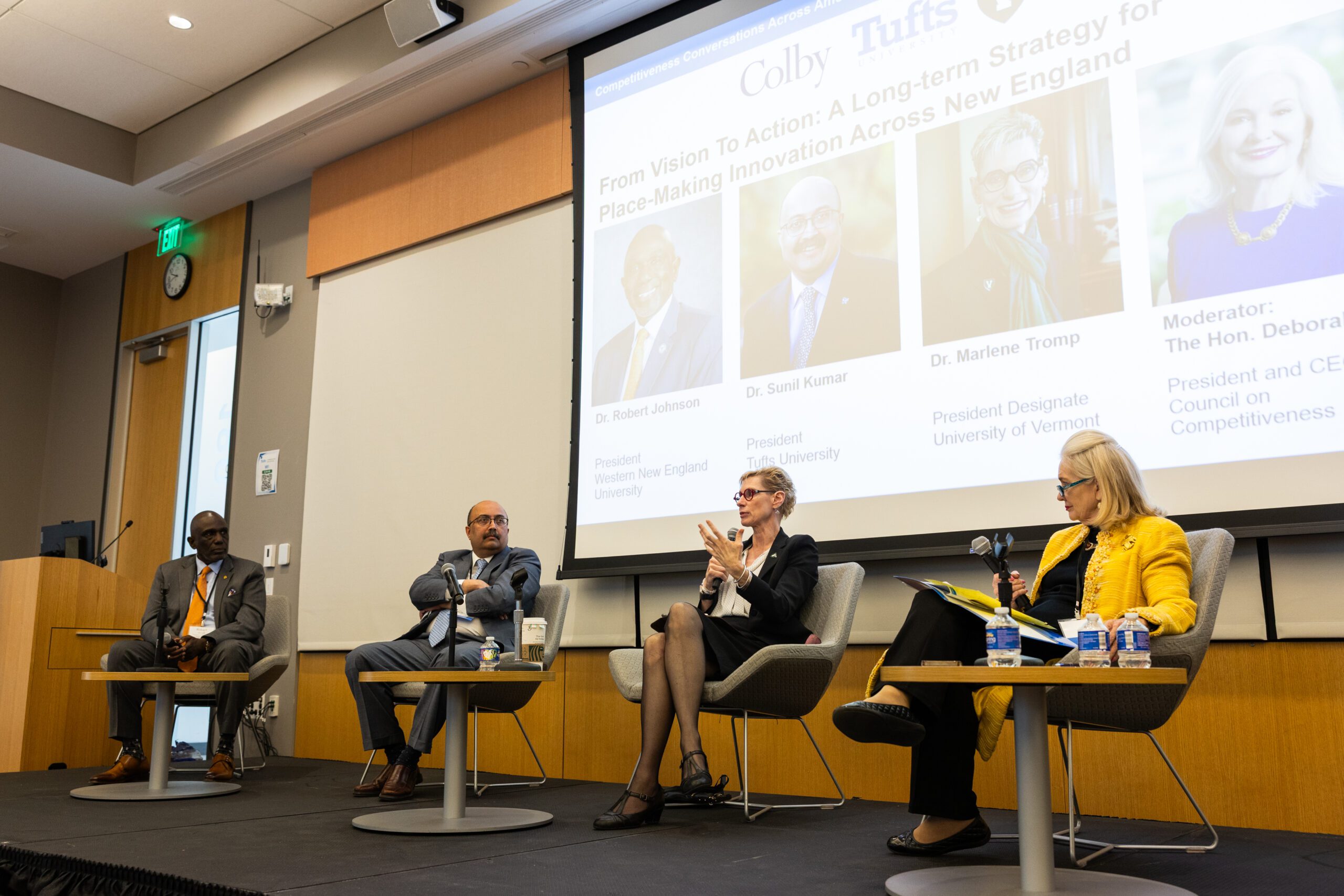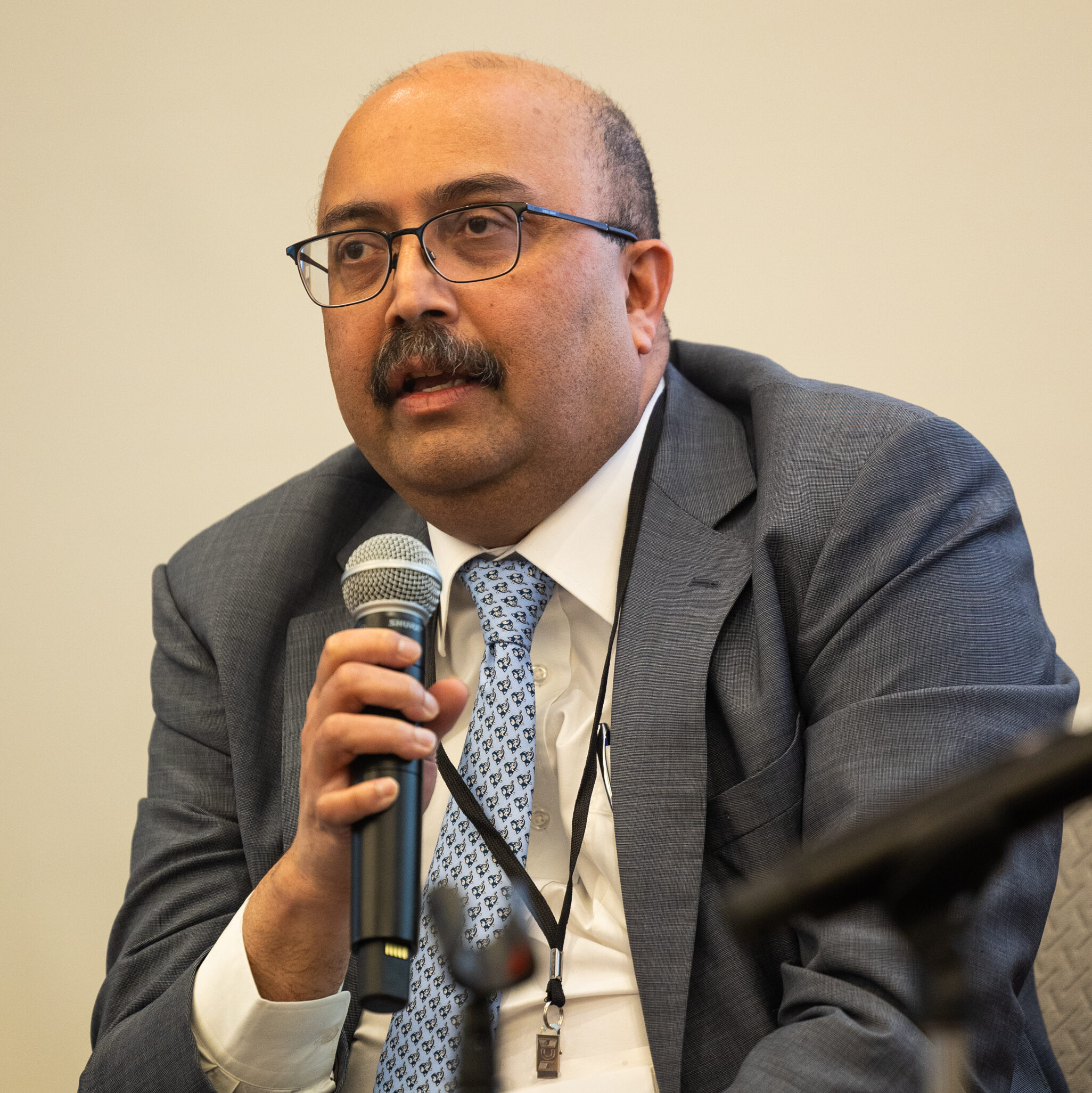
Dr. Robert Johnson
President, Western New England University
Dr. Sunil Kumar
President, Tufts University
Dr. Marlene Tromp
President Designate, University of Vermont
Moderator: The Hon. Deborah L. Wince-Smith
President and CEO, Council on Competitiveness
The region and nation with the most efficient and sustainable economy will hold a competitive advantage over its rivals. This concluding panel examined the path forward for New England to position itself as a leader in tomorrow’s blue-green economy—as well as the lessons that can be shared to optimize the U.S. economy for a future in which sustainability and innovation will be increasingly linked.
To begin, Council on Competitiveness President and CEO Deborah Wince-Smith asked each of her university co-hosts for their top-level thoughts as the Conversation came to a close. Western New England University President Robert Johnson was clear that the most valuable ingredient in the New England innovation economy was its people, but that those people were going to have to learn to adapt faster than ever before. It took a century to go from the steamboat to the combustion engine – but, as Dr. Johnson asked, how many revolutions have we seen in just the past decade? Students – as well as industry, academia, and government – need to get more comfortable with the process of learning, unlearning, and relearning as technologies like AI rapidly reshape the world around us. Paradoxically, agility amongst uncertainty needs to become the new steady state for New England.

"The agile mindset of "learning, unlearning, and relearning" is not just for students; it is for industry, academia, and faculty. The ways that we are used to doing things, some we will have to unlearn and learn something new, particularly with the introduction of AI."
Dr. Robert Johnson
President
Western New England University
One of the biggest takeaways for Tufts University President Sunil Kumar was how he evaluated the legacy of Vannevar Bush and his “Endless Frontier” model of U.S. research. His model solved the problem of how to scale innovation but created what Dr. Kumar called a “centripetal” model centered around universities, leaving many people behind. In his view, pursuing the Blue and Green – or, as he coined them, “Teal” – economies was a great opportunity for all of New England, and it would be a shame to dig a “moat” around the Boston metro area that excluded others. Even New Bedford, just thirty miles away, had been broadly excluded from the Boston higher education ecosystem. Dr. Kumar was adamant that universities need to go out to places like New Bedford, rather than expecting New Bedford to come to them. A renewed local focus will be critical in other ways; he argued that too great a focus on solving global problems would lead researchers to neglect local needs. Local economic development needs to remain front and center; New England needs to be a place welcoming to the four-person startup and the 40,000-person giant. If it is not, there is a lot of shoreline in the world – companies will find somewhere else to set up shop.

"Vannevar Bush solved one problem, but created another. He solved how to create innovation at scale, but he built a centripetal, inward-facing model around universities. That left a lot of people out."
Dr. Sunil Kumar
President
Tufts University
University of Vermont President Designate Marlene Tromp emphatically agreed that universities cannot expect all the attention to run "downhill” towards them. Dr. Tromp spoke on the Conversation’s first panel about the need to reach rural students where they are, rather than expecting them to funnel into cities. She doubled down on that point, citing the need to ensure “placebound” students still have opportunities. If they are not reached, then they will be forced to choose between either second-rate opportunities or leaving New England for good – accelerating the region’s outward migration. Dr. Johnson echoed her point, desiring to get away from the idea of “educational deserts” without opportunity. While Boston is flush with universities, the rest of New England has plenty of potential students – but no way to educate them without asking them to pick up and move away from home to an expensive urban area. For Dr. Johnson, there is no “demographic cliff” for New England; the young people are there, they just need to be reached.
The Hon. Wince-Smith pointed to the example of New Bedford as a model for the rest of New England. A decade ago, the city was in dire economic and social straits, seemingly on its way towards inevitable decline. But through a risk-taking, thriftiness, and “Yankee Ingenuity,” the city’s leadership had managed to turn the ship around. A similar story played out across the Atlantic in the West Midlands of the United Kingdom, where Aston University is leading an economic revival without the help of the national government. This attitude of shaping one’s own destiny will be a critical factor shaping New England’s success in the years to come. Dr. Johnson emphatically agreed, citing the need to recapture the “can-do” attitude and human spirit that built this country for the 21st century. Dr. Tromp, a Victorianist, referenced a characterization about Americans from that period: “a nation of rapscallion dreamers who crossed an ocean with no money.” Those dreamers did and built things not for their own benefit, but for the benefit of the generations that would come after. While people want progress and innovation to happen quickly, it is a time-intensive process; failures and setbacks will happen, so patience is essential when considering investment. Dr. Tromp mentioned that, when higher education came under attack, there was not enough pushback, leading to demoralization in universities today. Universities need to convince the public that investment in universities is a part of that long-running American tradition of exploring, experimenting, and investing in the future.

"We have to help people understand that investment in higher education is an investment in our nation's, states', and communities' futures. And we need to help our faculty be inspired by that vision and that mission."
Dr. Marlene Tromp
President Designate
University of Vermont
Looking back into history for inspiration himself, Dr. Kumar told the story of how he was currently in conflict with the Duke of Northumberland in the United Kingdom over an artifact in the Duke’s possession: the oldest known map of the Revolutionary War. Known as the “Map of Medford,” having the artifact back in New England would be a point of pride for Tufts. Dr. Kumar shared the story to make two points: first, place-making innovation required a sense of hubris – you need to be willing to walk up to someone and say, “this map is ours.” Second, you have to take your sense of place seriously. If he wanted, he could likely get the Smithsonian involved and return the map to U.S. soil – but then, it would no longer belong to New England. If you want to lead in place-making innovation, you need to be willing to go it alone.
Zooming in on one sector New England’s innovation economy, the Hon. Wince-Smith asked whether her fellow panelists thought the region could successfully revitalize its shipbuilding sector. Dr. Kumar was clear: it had to. According to him, the oceans are a more challenging domain to operate in than space, and New England has always stood at the forefront of exploration. New England already builds the most advanced ships in the world at U.S. Navy shipyards in New London, CT, and is leading the world in the development of underwater autonomous vehicles. Dr. Tromp called the shipbuilding industry a metaphor for the New England innovation economy as a whole: while the new ships may not look like the ones of old, New England is still at the forefront of their development.
Asked for one final word to take away from the Conversation, Dr. Kumar offered “geographic advantage;” New England has a deep connection to its coast, and it needs to leverage that to succeed in the new century. Dr. Tromp offered up “rerisking:” rediscovering the willingness to take risks and be bold. Dr. Johnson supported that idea, reiterating that it would be the human spirit that ultimately determines New England success. The Hon. Wince Smith left them with a quote from the father of the U.S. Navy, John Paul Jones: “Those who do not risk cannot win.”

"The U.S. Naval Academy still teaches celestial navigation, navigating by the stars, in case of an emergency. We are all navigating out into the unknown, and we do not know what we are going to find, but we need to be ready for anything."
The Hon. Deborah L. Wince-Smith
President and CEO
Council on Competitiveness